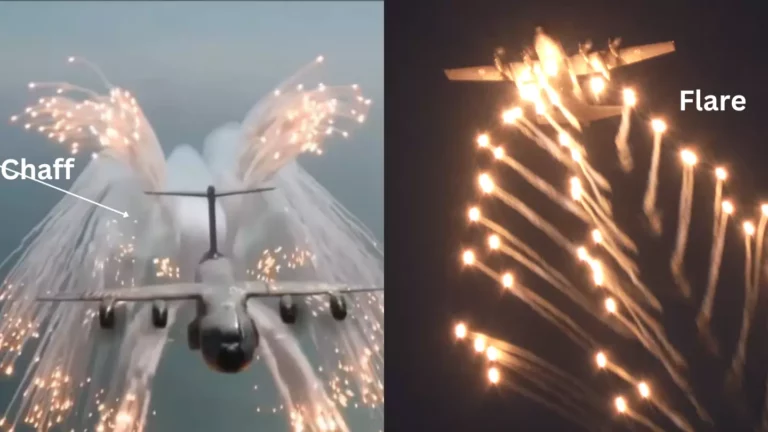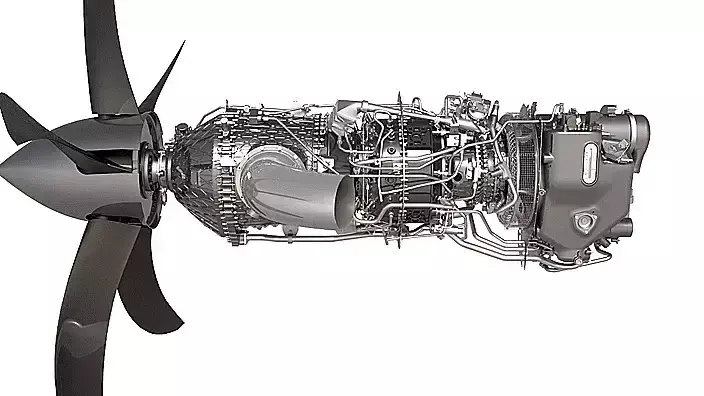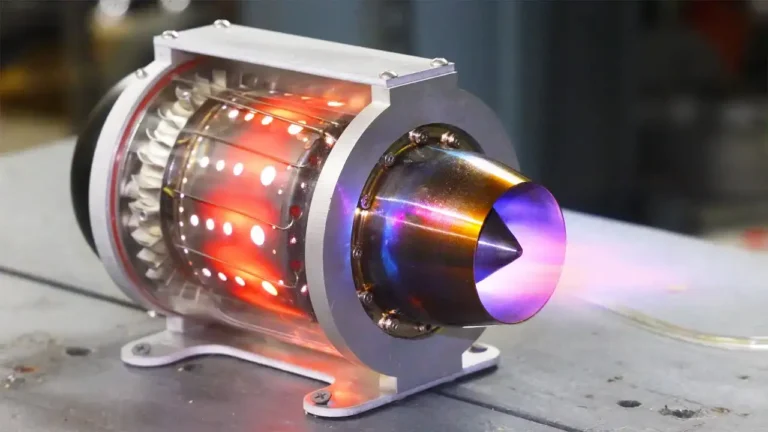What Is A Jet Engine, How It Works And Its Types
What Is A Jet Engine?
A jet engine is a type of reaction engine discharging a fast-moving jet that generates thrust by jet propulsion.
This broad definition of a jet engine can include rocket, water jet, and hybrid propulsion engines, but the typical meaning is the internal combustion airbreathing engine such as a turbojet, turbofan, ramjet, or pulse jet. Generally, jet engines are internal combustion engines.
Airbreathing jet engines typically feature a rotating compressor powered by a turbine, and the leftover power provides thrust through the propelling nozzle. The process is called the Brayton cycle, and it’s used in many airliners and business jets.
Aircraft today use more efficient turbofan engines for longer-distance travel.
Most are using advanced high bypass turbofan engines in the latest generation of advanced jet fighter aircraft.
An aircraft propelled by a jet engine flies at a higher speed and has greater fuel efficiency than piston engines, and propeller aero-engines can give long distances.
Propeller aero-engines cover long distances. They give higher speed and greater fuel efficiency than piston engines. In high-speed applications, ramjets and scramjets use the ram effect of the vehicle’s speed instead of a mechanical compressor.
History Of Jet Engine
The aeolipile was created as a curiosity in 150 BCE and was never used for any practical purpose. Chinese artists implemented the first practical use of jet propulsion in the 13th century. Between the 1600s and World War II, many scientists experimented with hybrid engines to propel aircraft.
In 1633, Ottoman Lagari Hasan Çelebi used a cone-shaped rocket powered by jet propulsion to fly up into the air with the help of wings and land successfully.
There are many theories about the history of jet engines, but the information shows that Frank Whittle invented the first jet engine in 1884. It was used on the world’s first successful aircraft, the Gloster E.1/40. In the 1930s, the German scientist Hans von Ohain developed the first practical jet engine. He later went on to develop the world’s first operational jet fighter, the Messerschmitt Me 262. Dr. Hans von Ohain of Germany was the designer of the first operational jet engine, though credit for the invention went to Great Britain’s Frank Whittle.
The key to a practical jet engine is the gas turbine, which extracts energy from the engine to drive the compressor. The gas turbine was first patented by John Barber in England in 1791. The first successful self-sustaining gas turbine was built by Norwegian engineer Ægidius Elling in 1903. Design and engineering limitations prevented the widespread manufacture of gas turbines until recently.
Mini Jet Engine
Mini jet engines are the same as traditional ones, but with a smaller size. They’re used in both Manned and Unmanned aircraft. RC Model Jet Engines are used in remote-controlled toys like RC Heli, Jets, or Autogyros (though these days, they’re more often than not on gas). The most common type of model gas turbine is the centrifugal flow turbine, as opposed to the lengthier axial flow turbine.
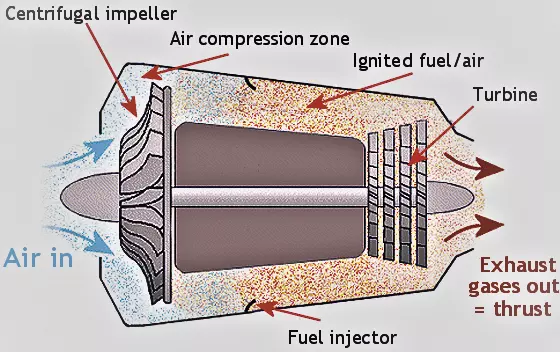
How Does A Jet Engine Work?
Jet engines move the airplane forward with a terrific force that produces thrust and cause it to fly at high speed.
All jet engines work the same way; they’re all powered by the combustion of fuel. The engine sucks in air with a fan. A compressor raises the pressure of the air. The compressor is made with many blades attached to a shaft.
The blades spin at very high speed and compress the air or squeeze it. Then compressed air is sprayed with fuel and electric spark ignites the air and fuel mixture. Burning gases expand and go out through the nozzle in very high speed, at the back of the engine.
As the gas pressure shoot backward, the engine create thrust and make aircraft to move forward. There is Turbine attached to the shaft at the back of the engine and when gas go out with pressure the turbine rotates and this rotation or spinning causes the compressor to spin.
The image below shows how the air flows through the engine. The air goes through the core of the engine as well as around the core. This causes some of the air to be very hot and some to be cooler. The cooler air mixes with the hot air at the engine exit area.
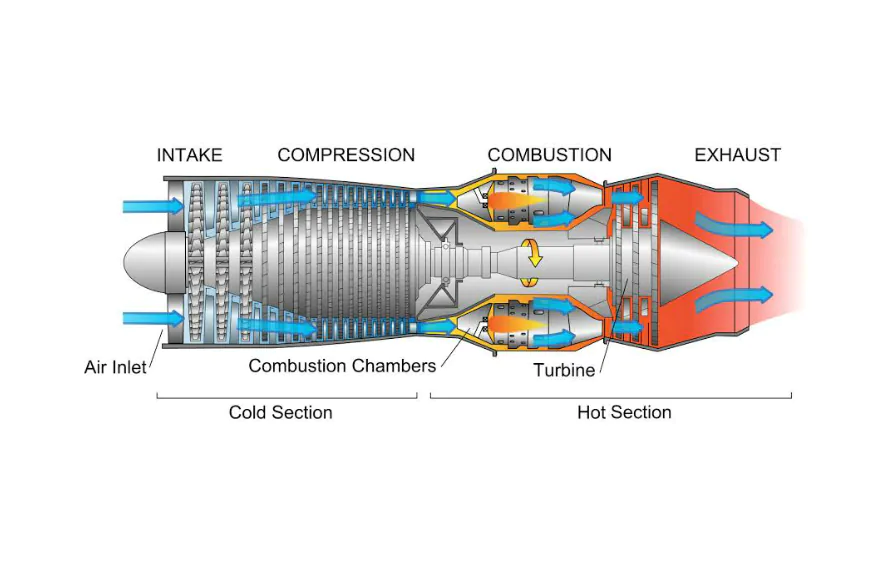
What Is Thrust?
Thrust is the forward force that pushes the engine and the airplane forward. Sir Isaac Newton (Newton Law) discovered that for “every action there is an equal and opposite reaction.” Jet engine uses the this principle.
As you read it above that the engine takes in a large volume of air from inlet and then air is compressed, heated and slowed down with diffuser blades to cool it again. After that air is mixed with jet fuel and ignite it. The temperature of the air can be as high as three thousand degrees.
The power of the air is used to turn the turbine. Finally, when the air leaves or go out of the engine. This causes the plane to move forward.
1. Fan
The fan is the first component of a turbofan. The large fan sucks in large quantity of air. The blades of the fan are usually made of titanium.
Then the air gets accelerated to higher speeds, and it is split into two parts. One part of the air travels through the “core” or center of the engine and is acted upon by the other engine components.
The second part “bypasses” the core of the engine. It goes through a duct that surrounds the core to the back of the engine where it produces much of the force that propels the airplane forward.
When working on an airplane engine, the best thing you can do is help to make the plane go faster by cooling it down.
2. Jet Engine Compressor
The compressor is the first component in the engine core. A gas turbine compressor is made of fans and may have many blades, and it is connected to a shaft. The compressor squeezes the air that enters it into progressively smaller areas, resulting in an increase in the air pressure.
This will increase your energy potential. The compressed air is forced into the combustion chamber.
3. Combustor
In the combustion chamber, the air is mixed with the fuel, and then ignited. There are as many as 20 nozzles to spray fuel into the airstream. The fuel in the air burns, which provides a high temperature, high energy airflow.
The fuel burns with the oxygen in the compressed air, producing hot expanding gases.
The inside of the combustion chamber is often made of ceramic materials so that it’s heat-resistant.
The temperature can get so hot that it can reach 2700°.
4. Turbine
The high-energy airflow coming from the combustor goes into the turbine, which causes the turbine blades to spin.
The turbines are connected by a shaft to the compressor which turns the blades in the compressor, and to spin the front intake fan.
This rotation takes energy from the high-energy flow that drives the fan and the compressor. The gases move from combustion chamber to the turbine and spin its blades. Turbines spin around thousands of times. Turbine is attached to shaft with the help of ball-bearing so it can rotate freely.
5. Nozzle
The nozzle is the exhaust duct of the engine. This is the part of the engine that actually produces the thrust.
The jet engine creates an outflow of high-velocity hot air, which causes the thrust to act like the force of an ejected rocket, propelling the aircraft forward.
Types Of Jet Engines
The 5 Main Types of Aircraft Jet Engines
- Turboprop Engine
- Turbojet Engine
- Turboshaft Engine
- Turbofan Engine
- Ramjet Engine


